The ESSENTIAL Nonprofit Board Member Guide & Board Templates
A nonprofit board member is critical to an organization’s health and long-term success.
This guide is aimed to help founders, nonprofit board members, and anyone who’d like to invest in improving the current functioning of their nonprofit board of directors.
In it, we cover setting up a nonprofit board, hosting nonprofit board meetings, establishing board member responsibilities, and managing your board, and we include board templates to help with all of this!
Here’s what we’ll cover:
- The Ideal Size of a Nonprofit Board
- Nonprofit Board Recruitment + Recruitment Templates
- Nonprofit Board Member Skills
- How Long Should Board Members Serve
- Your First Nonprofit Board Meeting + Board Meeting Templates
- Creating a Board Meeting Calendar + Calendar Template
- How to Host Effective Board Meetings
- Nonprofit Board of Directors Responsibilities + Checklists & Templates
- Common Nonprofit Board Positions
- Nonprofit Board Committees
- Adopting Effective Board Policies + Board Policy Templates
- Nonprofit Board Orientation
- Nonprofit Board Training
- Assessing the Health of Your Board
1. Setting Up a Nonprofit Board of Directors
Let’s get started on learning how a nonprofit board of directors is set up. A founder usually has a few nonprofit board positions they would like to fill and chooses members according to their influence and skills. A committed, involved, and resourceful nonprofit board is one of the most valuable resources for institution-building and fundraising.
The Ideal Size of a Nonprofit Board
The ideal size of a nonprofit board should be determined by the needs of the founder and the size of the organization.
If it’s just started, having a large nonprofit board of directors with multiple committees may not be the most efficient.
Three board members is the most common minimum number for a board, and the max can range to 15.
Three board members is the most common minimum number for a board, and the max can range to 15.
While this is not legally mandated, most nonprofits adhere to these limits since boards larger than 15 can make decision-making difficult and nonprofit boards smaller than three might not include diverse perspectives.
Nonprofit Board Recruitment
While this is not legally mandated, most nonprofits adhere to these limits since boards larger than 15 can make decision-making difficult and nonprofit boards smaller than three might not include diverse perspectives.
Founders and board members are involved in finding the right candidate for open nonprofit board positions. The process can be tough, but with a little planning, it doesn’t have to be!
Think strategically about how many board members you need to recruit and start the process early so that you have a number of strong candidates from which you can choose.
Here’s a few places where you can recruit your nonprofit board of directors:
- Professional associations: If you or your staff are part of any professional or alumni associations, this is a great place to start. You can also approach professional associations, keeping in mind specific skills you’d like board members to have, such as management, marketing, sector experience, etc.
- Board member networking reception: A unique way to recruit nonprofit board members is to host a networking reception of potential candidates. Some organizations host small gatherings introducing potential nonprofit board candidates to existing members to get their inputs.
- Other nonprofits: While other nonprofits might be reluctant to share their networks, asking them informally about potential candidates to recruit or ideas on how to find candidates is a great idea! They may even connect you with one of their board members whose term is ending.
- Organizations that train board members: Organizations or associations that host training sessions for board members have a pool of candidates already interested and ready for the job.
- Local businesses and community groups: If your organization has a strong local connection, recruiting a local business leader could benefit fundraising and boost your position in the community.
- Personal networks: Save this category as a last resort, unless you have someone specific in mind. Don’t limit yourself to your own friends and family. However, you can reach out to the personal network of the organization’s staff.
The Board of Directors Recruitment Grid Template below is ideal for assessing the skills needed for any open nonprofit board positions. Get this one and other nonprofit board templates in My Board View , a free board portal for nonprofits.
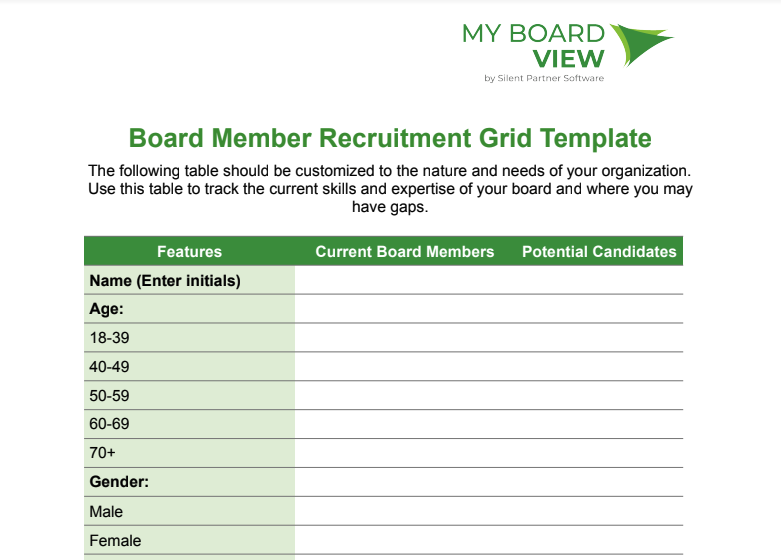
Nonprofit Board Members Skills
Nonprofit board positions are strategically filled. A board’s expertise needs to reflect the skills required for the organization to succeed. Whether you’re being recruited for the first time or not, you’ll need to fully understand how your skills could impact the organization.
Here are a few questions to think about when asked to join a nonprofit board:
- If the organization has just started, do you have the expertise needed to initiate an organization?
- Do you understand the nonprofit’s mission?
- Are you passionate about the cause?
- How will you fit with the rest of the nonprofit board members?
- What type of person do they need to achieve their goals?
- What skills are they missing on their current board? Do you have these skills?
- Can you make time for the organization?
- What local community connections and networks can you leverage?
- What is your capacity to give?
Founders may also want to take into account gender, age, ethnicity, and other factors to ensure diversity amongst the different nonprofit board positions.
The Nonprofit Board Member Orientation Checklist Template below will help with onboarding new board members. Get this one and other nonprofit board templates in My Board View , a free board portal for nonprofits.
This will help the organization account for different perspectives and make better decisions.
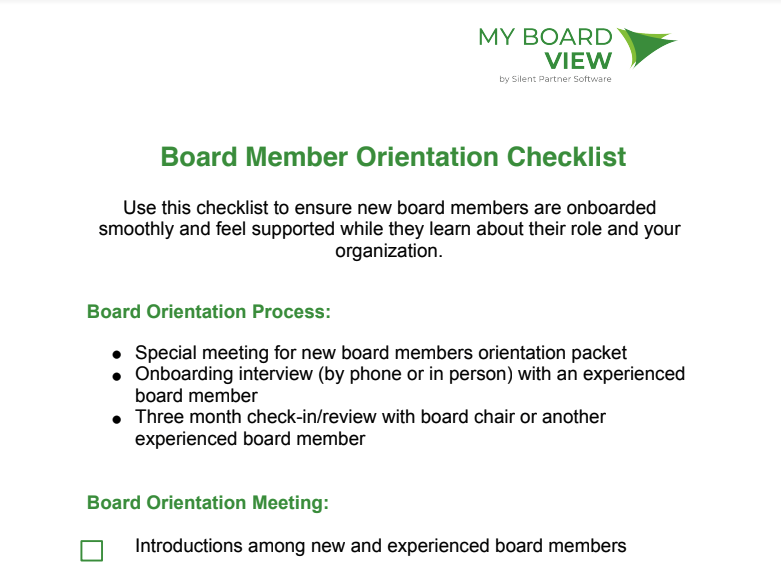
How Long Should Nonprofit Board Members Serve?
Nonprofit boards typically serve two-year terms and can be invited to serve two terms consecutively. It is also very common for nonprofit board members to serve two consecutive three-year terms.
Terms are not legally mandated in the US or Canada, but certain guidelines exist that require compliance. For example, in Ontario, the Not-for-Profit Corporations Act (ONCA) states that a nonprofit board member should have a minimum term of one year and a maximum term of four years.
While setting terms, you may also want to create a staggered term system that allows a certain number of nonprofit board positions to become open each year. This regulation prevents the terms of other nonprofit board members from expiring at the same time as yours.
Term limits enable the board to adjust its leadership to changing needs, protect the board from ineffective members, and allow the organization to work with experts who may only be able to devote a few years to board service.
Term limits enable the board to adjust its leadership to changing needs, protect the board from ineffective members, and allow the organization to work with experts who may only be able to devote a few years to board service.
Although the US does allow for paid board positions, most board members are not compensated for their service, so don’t expect to be paid!
2. Hosting Nonprofit Board Meetings
Nonprofit board meetings update members on important information, provide clarity on the organization’s functioning, decide policy, connect board members, and are critical to the organization’s growth!
Your First Nonprofit Board Meeting
Your first nonprofit board meeting is one of the most important meetings you will host. Here are a few things that must be dealt with during the first meeting:
- Fix the name and the legal address of the organization
- Elect a nonprofit board of directors and authorize them to make business decisions (like open bank accounts, sign checks, etc.)
- Apply for tax-exempt status
- Adopt nonprofit board bylaws (make sure they’re drafted before the meeting!)
- Approve the mission statement and vision of the organization
- Approve articles of incorporation and other legally required documentation
- Approve rough drafts of your strategic plan and budget
The Board Meeting Agenda Template below will help ensure board meetings are organized. Get this one and other nonprofit board templates in My Board View , a free board portal for nonprofits .
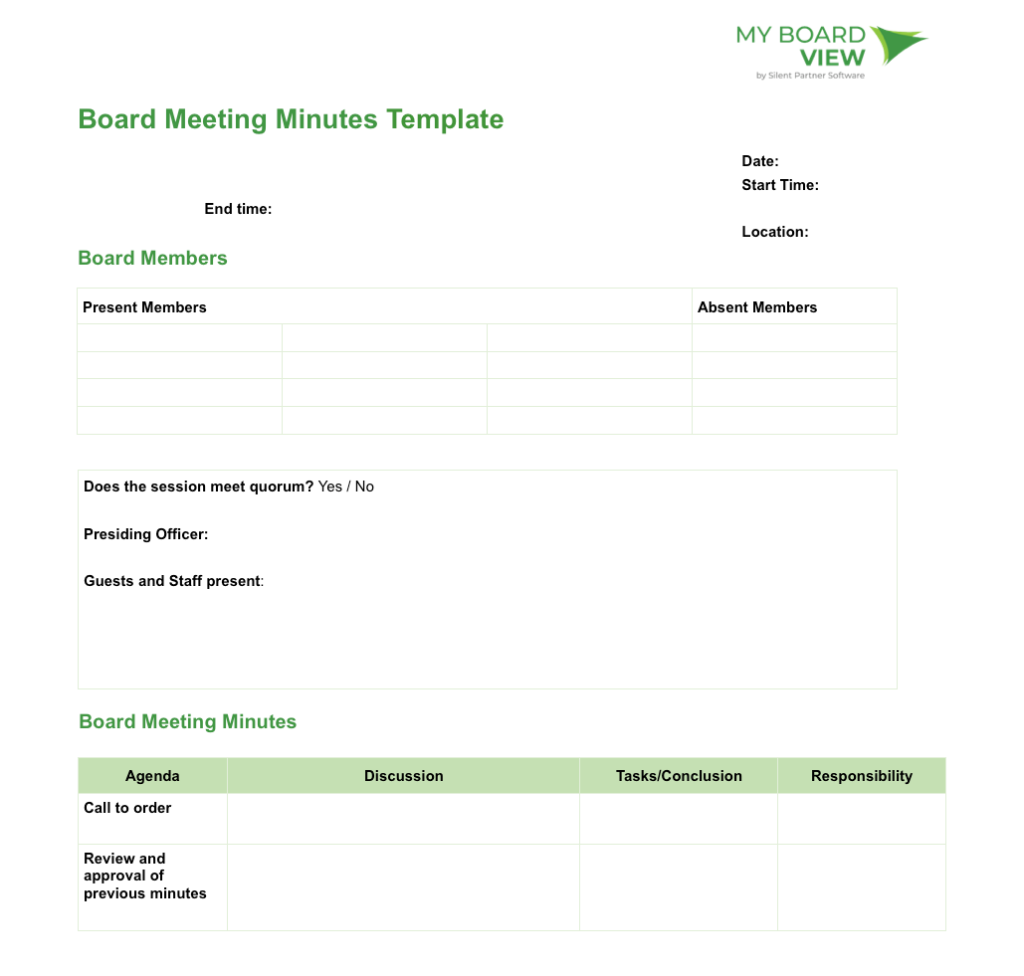
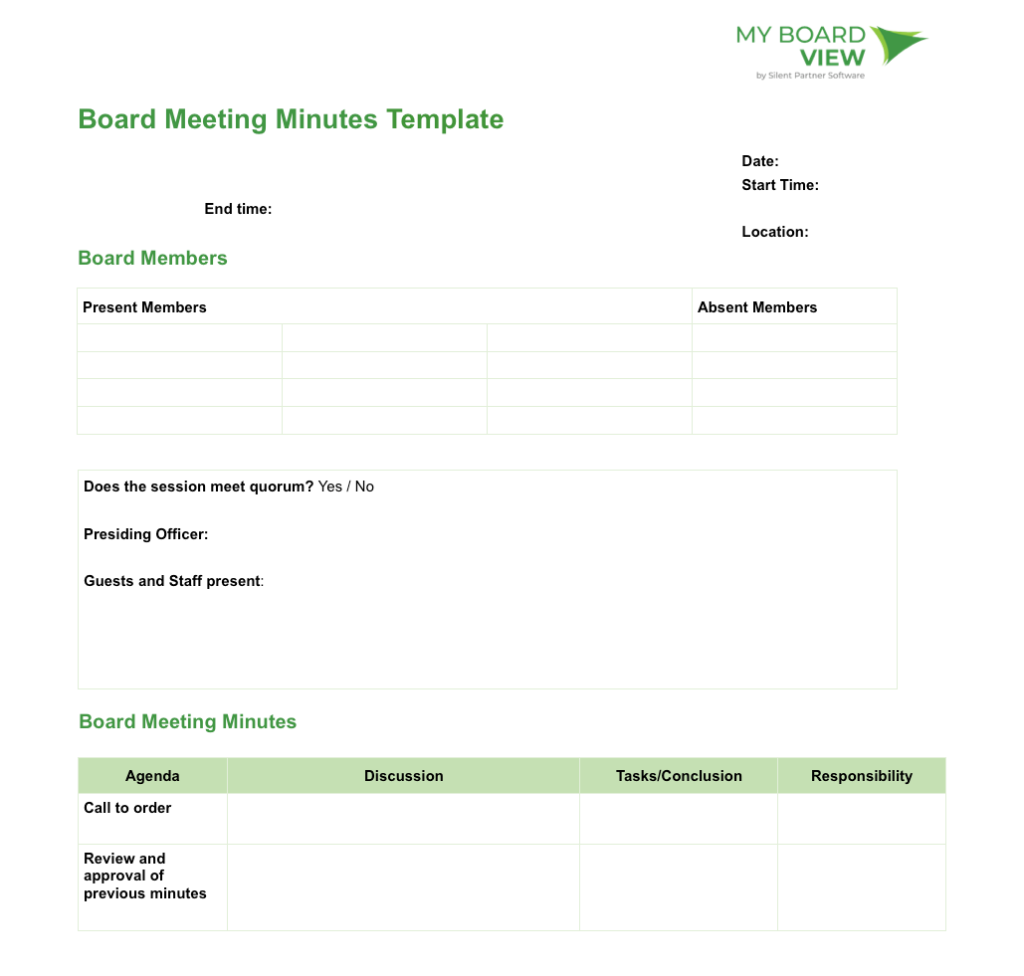
Creating a Board Meeting Calendar
It’s important to determine your nonprofit board meeting schedule a year in advance to give members enough time to plan.
Most nonprofits schedule quarterly or bi-annual board meetings, depending on the decisions needing to be made. If the organization is in the process of setting up, you may function like a “working board of directors” and meet more often to determine the policies and governance of the organization.
The Nonprofit Board Meeting Calendar Template below will help you plan board meetings effectively. Get this one and other nonprofit board templates in My Board View , a free board portal for nonprofits.
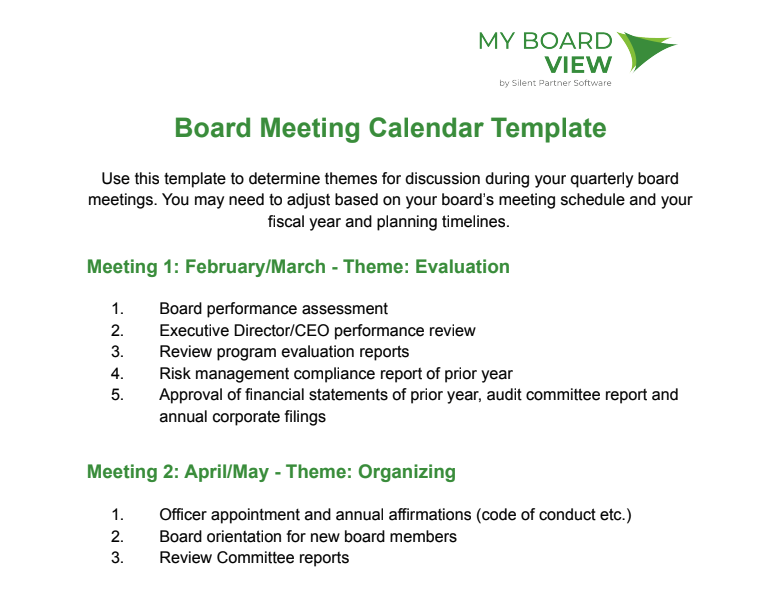
How to Host Effective Board Meetings
A nonprofit board meeting isn’t the time to start work; they’re not the place to begin reviewing policies or reading material shared earlier.
Nonprofit board meetings are opportunities for decision-makers to connect, discuss challenges, and make strategic decisions. Effective board meetings require preparation to succeed and should leave members feeling inspired, informed, and heard.
Here are some tips on hosting effective nonprofit board meetings:
- Start and end on time. Board members are more likely to function at high energy levels with a strict time limit. Give each agenda item a time frame and assign a time monitor to keep everyone on track.
- Send the agenda early. Give board members enough time to review all materials and make sure they know this responsibility. Your executive director can also schedule one-on-one calls with members to ensure materials are read and answer any questions or doubts.
- Discuss important agenda items first. Scheduling important items early on your board meeting agenda will bring everyone’s full attention to the matter at hand rather than waiting till the end when energy and concentration are low.
- Take detailed minutes and document decisions. Board minutes are legal documents, so make sure someone is responsible for noting discussions at every nonprofit board meeting. Use a nonprofit board meeting minutes template to enter information easily.
- Give everyone a chance to speak. Your board members may not all be vocal but will have valuable components to contribute. It is the responsibility of the Chair to ensure that everyone’s voice is heard and no one person is allowed to dominate the meeting.
- Set an agreeable meeting frequency. If your quarterly board meetings last over two-hours and nonprofit board members complain about their length, discuss the issue with directors and consider meeting monthly instead.
- Keep meetings focused. Focus on board meeting agenda items as much as possible and ensure the Board Chair has the authority to interrupt or steer members away from tangential discussions. This focusing will put your board members’ time to good use and make them feel productive and effective.
- Ensure nonprofit board of directors responsibilities are clearly communicated. A clear understanding of roles makes meetings run smoothly since members are engaged and know how to make an impact. They’re also more likely to contribute in meetings and be attentive.
- Rotate Chairs and leads for each section. Having just one person present during a board meeting is a surefire way to lose attention. Instead, have different committee Chairs lead discussions. Listening to a new person helps reengage nonprofit board members and allows for more vibrant discussions.
- Co-create board meeting rules. Get buy-in from the entire board about the structure, rules, and expectations during board meetings. Setting co-created meeting rules and asking for feedback makes it more likely they will be followed.
- Present updates engagingly. As part of the expectations you set, make sure board members aren’t reading from notes while presenting their reports. Instead, make sure they present their views, insights, and learnings.
- Recognize philanthropy and board fundraising efforts. Build a culture of philanthropy and highlight the importance of giving by recognizing significant gifts made by your nonprofit board of directors.
- Set aside time for organizational updates. Allocate time for the executive director to present the status of the organization relating to its benchmarks and strategic plans.
- Set follow-up tasks for board members. Make sure nonprofit board members leave with a list of tasks to accomplish before the next meeting.
3. Nonprofit Board Roles and Responsibilities
A nonprofit board of directors has many responsibilities, as members will be involved in governing an organization and fulfilling its mission.
Nonprofit boards provide critical legal, financial, and administrative oversight, so your decisions and advice can be central to how an organization functions.
All nonprofit board members must agree to work honestly, keep matters confidential, and act in the best interests of the organization.
This streamlining also involves declaring any conflicts of interest and declining to vote or discuss matters where conflict may occur.
Nonprofit Board Of Directors Responsibilities
Here are a few basic nonprofit board of directors responsibilities:
- Strategic planning and mission building: A nonprofit board designs and approves strategic plans that take into account the organization’s mission, community needs, and the context in which a nonprofit operates. Once overall goals are set, the board also evaluates the success of these plans and determines how satisfied beneficiaries are with the program.
- Financial oversight: A nonprofit board is also responsible for closely monitoring financial activity, including expenses, staff salaries, and the cost of programs and services. It determines whether these costs are justified, approves budgets, and puts internal controls in place to prevent the misuse of funds.
- Fundraising: Fundraising is a key priority for nonprofit board members. When asked to fill new nonprofit board positions, make sure you are aware of any fundraising expectations. Some organizations require board members to contribute a minimum amount per year, while others ask that they commit to raising a certain amount. Regardless of their area of expertise, nonprofit board members will be involved in fundraising in some capacity during the year.
- Awareness and visibility: Board members are advocates in public society. Nonprofit board members build and maintain relationships that can help a nonprofit meet its goals, whether through fundraising, programs, or raising awareness.
- Recruitment: A nonprofit board of directors has one employee to oversee: the executive director or CEO. They are responsible for hiring, compensating, and evaluating the ED. While the founder usually fills the role of the ED, a nonprofit board is responsible for any future hiring at this level.
- Legal compliance: All legal compliance and governance issues are the responsibility of the nonprofit board of directors. They ensure all annual paperwork, tax information, and permits are in place and submitted on time to national or local governing bodies. Nonprofit board members also set internal policies and bylaws and are required to adhere to them.
The Nonprofit Board Member Commitment Checklist Template below is great for ensuring you are aware of all responsibilities when interviewing/being interviewed as a potential nonprofit board member. Get this one and other nonprofit board templates in My Board View , a free board portal for nonprofits.
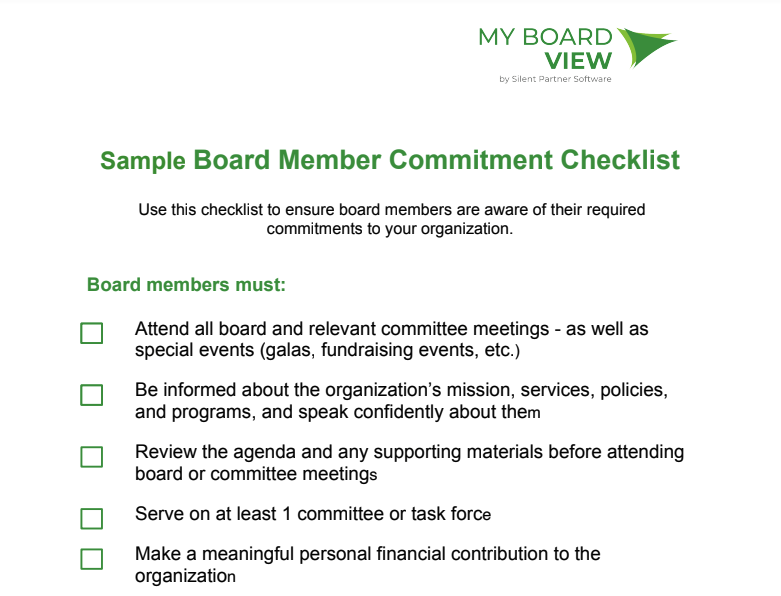
Common Nonprofit Board Positions
While a nonprofit board of directors can comprise three to 20 people, there are certain key nonprofit board positions. These include:
- Chair or president: The nonprofit board Chair oversees the work of the board and the organization’s senior management team. They are responsible for chairing board meetings, assigning nonprofit board of directors responsibilities, and calling for votes on new policies.
- Vice chair or vice president: The vice Chair supports the work of the Chair and other committee executives. They can also fill in for the Chair when needed. The VC works on special assignments and can lead nonprofit board committees.
- Secretary: The nonprofit board secretary is responsible for maintaining minutes, monitoring legal compliance of the organization, and ensuring members adhere to nonprofit board bylaws. Secretaries are usually required to be present at all board meetings.
- Treasurer: Treasurers are responsible for overseeing the finances of a nonprofit. They track budgets and expenditure, review external audits, and usually serve as Chairs of the finance committee. They also present the annual or quarterly budgets and flag any financial issues at board meetings.
- Other nonprofit board positions: For larger organizations, nonprofit board positions include fundraising Chair, programs Chair, finance Chair, or general members. These respective Chairs can also form committees to govern specific areas of the nonprofit.
Nonprofit Board Committees
Board committees are small groups of board members responsible for overseeing certain areas of work. While standing committees are permanent and operate throughout the year, ad hoc committees can be formed to tackle specific challenges and dissolved after the task has been accomplished.
Forming an ad hoc board committee is an effective way to engage nonprofit board members, put their skills to good use, and keep committees functioning with a clearly defined purpose.
Some examples of standing committees include:
- Governance committees are responsible for recruiting senior management, orienting new board members, and providing training opportunities. In larger nonprofits, a nominating committee within the Governance Committee is in charge of board recruitment and presents recommendations to the full board for approval.
- Finance committees are responsible for reviewing the organization’s finances, auditing, and accounting. It also helps manage potential financial risks and identifies gaps in funding. The treasurer usually Chairs this committee.
- Executive committees are responsible for dealing with critical issues that may require immediate action. It is typically composed of the executive director and board directors; it doesn’t include staff.
- Fundraising committees are responsible for planning and overseeing fundraising campaigns and events that occur throughout the year. The fundraising committee is also tasked with identifying external funding opportunities and grants.
4. Managing a Nonprofit Board
A strong board doesn’t always manage itself. While you may be part of a great nonprofit board, managing the board can be a challenge. A 2015 report from Stanford University found that 50% of nonprofit directors believe their fellow board members are not engaged in their work with the organization, while a third isn’t satisfied with the board’s ability to evaluate their organization’s performance.
So, how do nonprofit boards of directors work effectively? Adopt policies and practices that keep them on track, orient new members, conduct regular nonprofit board training, and assess the health of your board practices regularly.
You can also create a My Board View account and see how to use nonprofit board software to ensure that board members feel connected to your organization and involved in its success .
Adopting Effective Board Policies
A well-functioning nonprofit board has policies that are familiar to board members. Too often, nonprofit board bylaws are neglected, or members remain unaware of the policies that govern the board.
When setting up nonprofit board bylaws and policies, make sure these are discussed and approved regularly by your nonprofit board.
The following nonprofit policy templates and other nonprofit board templates are available in My Board View , a free board portal for nonprofits.
- Nonprofit Board Conflict of Interest Policy Template
- Nonprofit Board Conflict of Interest Statement
- Nonprofit Board Whistleblower Policy
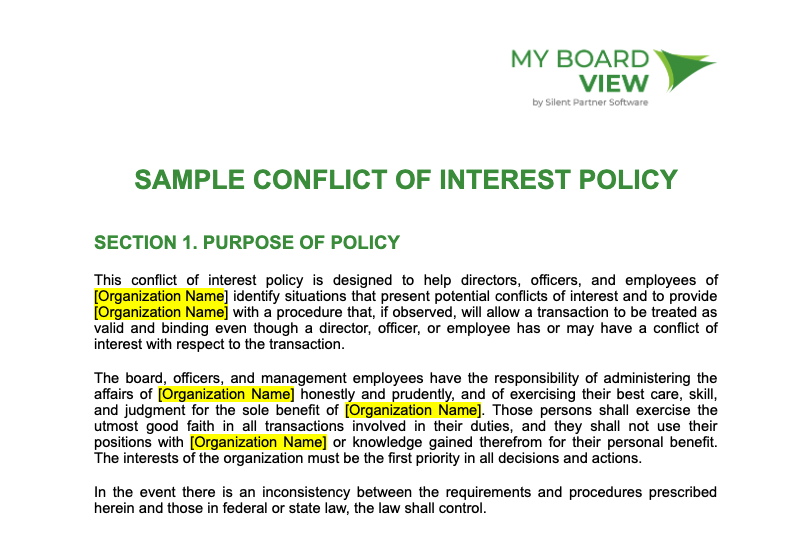
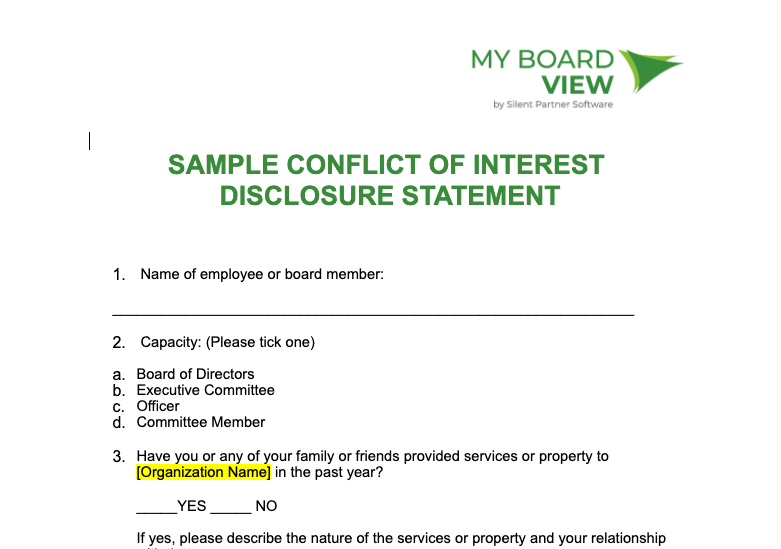
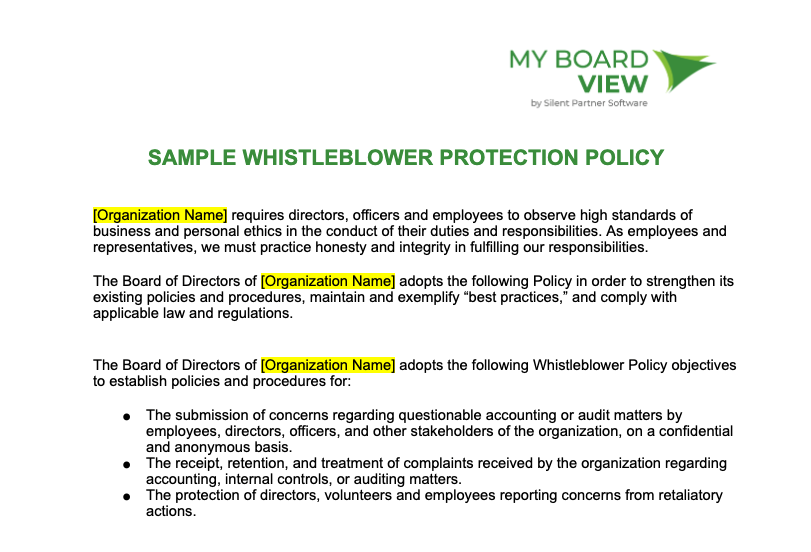
Checklist for Building Nonprofit Board Bylaws
Nonprofit board bylaws are legally binding rules that state how a nonprofit board operates. Bylaws must follow federal and state laws and comply with other policies and resolutions developed by your nonprofit board.
Your nonprofit board bylaws should be simple and include a few key items. Use this checklist to make sure you have everything covered:
❏ Statement limiting the personal liability of nonprofit board members (indemnification)
❏ Minimum and maximum number of board members
❏ Responsibilities of board members
❏ Number of board members required to approve decisions (quorum)
❏ Terms and term limits
❏ Nomination procedure
❏ Voting procedure
❏ Election procedure for nonprofit board members
❏ Removal procedure for board members
❏ Procedure for emergency board meetings
❏ Procedure for creating and dissolving board committees
❏ Procedure for selecting Chairs and committee members
❏ Minimum number of board meetings per year
❏ Current policies (conflict of interest, whistleblower policy, etc.)
❏ Current standing committees
❏ Procedure for changing nonprofit board bylaws
Nonprofit Board Orientation
Orienting new nonprofit board members is key to developing a healthy governing board. Here are a few tips to ensure new nonprofit board directors stay engaged and involved:
- Develop an orientation plan: To make new board members feel valued, it is important that their orientation is well-planned and makes them feel like they are part of a professional organization. Seek advice from nonprofit board members who have recently been recruited, and make sure you regularly review the board orientation procedure. This will ensure board members are well-informed about their role and arrive at board meetings prepared to contribute.
- Create a nonprofit board manual: A board manual is a useful introduction to both new and prospective nonprofit board members and should provide a concise overview of your organization, its programs, and financial status. Your manual should include:
- A history of your nonprofit
- Program highlights
- Fundraising one-pager (emphasize the fundraising obligation and how it can be met)
- Staff list
- List of nonprofit board positions, members, and committees
- Nonprofit board of director’s responsibilities
- Upcoming meetings and any important events
- Previous nonprofit board meeting minutes
- Nonprofit board training agenda
- Policies and nonprofit board bylaws
- Approved budget
- Legal and tax documents
A successful orientation should leave new nonprofit board members feeling well-informed, excited to share their role with their network, and ready to contribute from the first official meeting!
Nonprofit Board Training
Nonprofit board training isn’t just for new members. An educational session or board retreat can be used to educate members about a nonprofit board of director’s responsibilities, develop a bond with other members’ and problem solve for board-related concerns.
Here are a few tips on how to organize Nonprofit board training sessions:
- Offer special programs for board members with the option of online training sessions or webinars
- Ask for nonprofit board training sessions on fundraising, public relations, or programmatic concerns.
- Refresh knowledge of governance and basic roles and responsibilities of board members
- Ask the board chair of another nonprofit to present their experience in improving board functionality
- Conduct nonprofit board training at least once a year to ensure everyone is on the same page.
- Create a board development committee that ensures nonprofit board trainings are well-designed, useful, and occur at regular intervals
- Use insights from board self-evaluations to organize future nonprofit board training sessions
The Nonprofit Board Training Agenda Template below is great for ensuring you are getting each board member ready for the job. Get this one and other nonprofit board templates in My Board View , a free board portal for nonprofits.
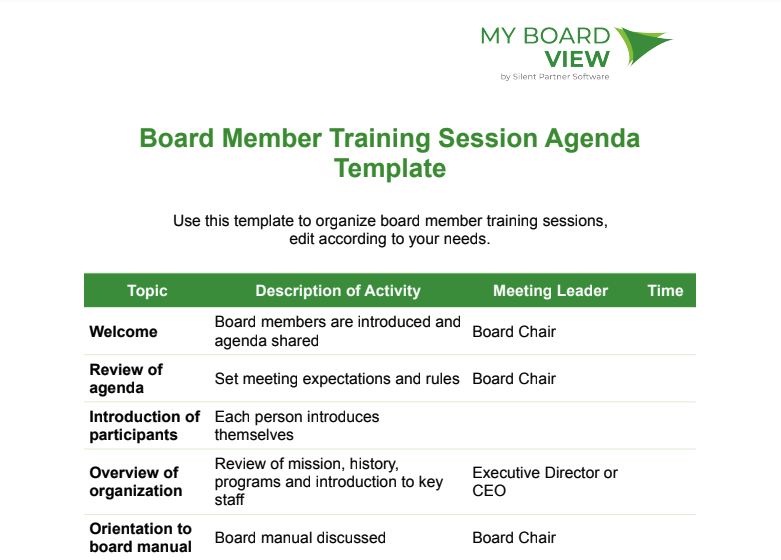
Assessing the Health of Your Board
Periodically assessing and updating board practices is key to a well-functioning nonprofit board.
You may want to create a governance committee that is tasked with educating the board and reviewing its policies.
The governance committee ensures nonprofit board of director’s responsibilities are clear, orients new board members, and reviews term limits and policies. You may also want to conduct board assessments, either through an external consultant or by organizing a self-assessment session.
Tips on getting a nonprofit board to deliver:
- See nonprofit board members as strategic partners to help leverage everyone’s expertise and demand more from each other.
- Clearly outline board responsibilities and ensure members are aware of their obligations.
- Set goals for each board member for fundraising, projects, or participation in a new strategy aligned with their skill set.
- Make sure board meetings are meaningful. Plan nonprofit board meetings in advance to keep focus and make sure they end on time. Share agenda and board meeting minutes well in advance to ensure everyone is able to come prepared. Lastly, make sure that all voices are heard and create time for open dialogue and discussion.
- Share organizational milestones to build a connection to the cause. Ask your ED to share videos, written stories, or even invite a special guest to tell their story during a nonprofit board meeting.
The Board Evaluation Template below will help to assess the health and performance of your board. Get this one and other nonprofit board templates in My Board View , a free board portal for nonprofits.
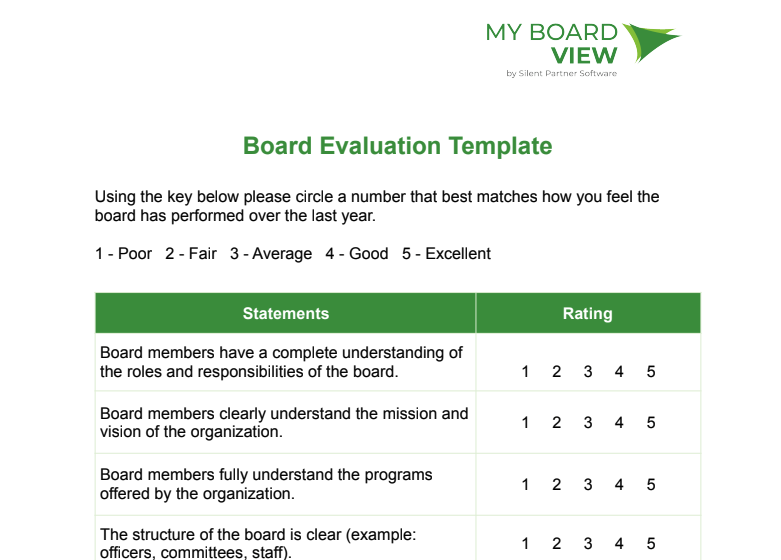
A Guide for Nonprofit Board Members: Recap
We hope this guide will help you organize your first board meeting, guide you on a nonprofit board of director’s responsibilities, and recruit committed and resourceful board members.
Here’s a list of the resources and templates included in this guide that are available in My Board View, a free board portal for nonprofits.
- Nonprofit board meeting minutes template
- Nonprofit board meeting agenda template
- Nonprofit board meeting calendar schedule template
- Nonprofit board member recruitment grid
- Nonprofit board member orientation checklist
- Nonprofit board member commitment checklist
- Agenda for nonprofit board training
- Nonprofit board evaluation template
Organization policy templates:
- Whistleblower policy template
- Conflict of interest policy template
- Conflict of interest disclosure statement
You Might Also Like:
Get More Blogs Like This Delivered To Your Inbox!












